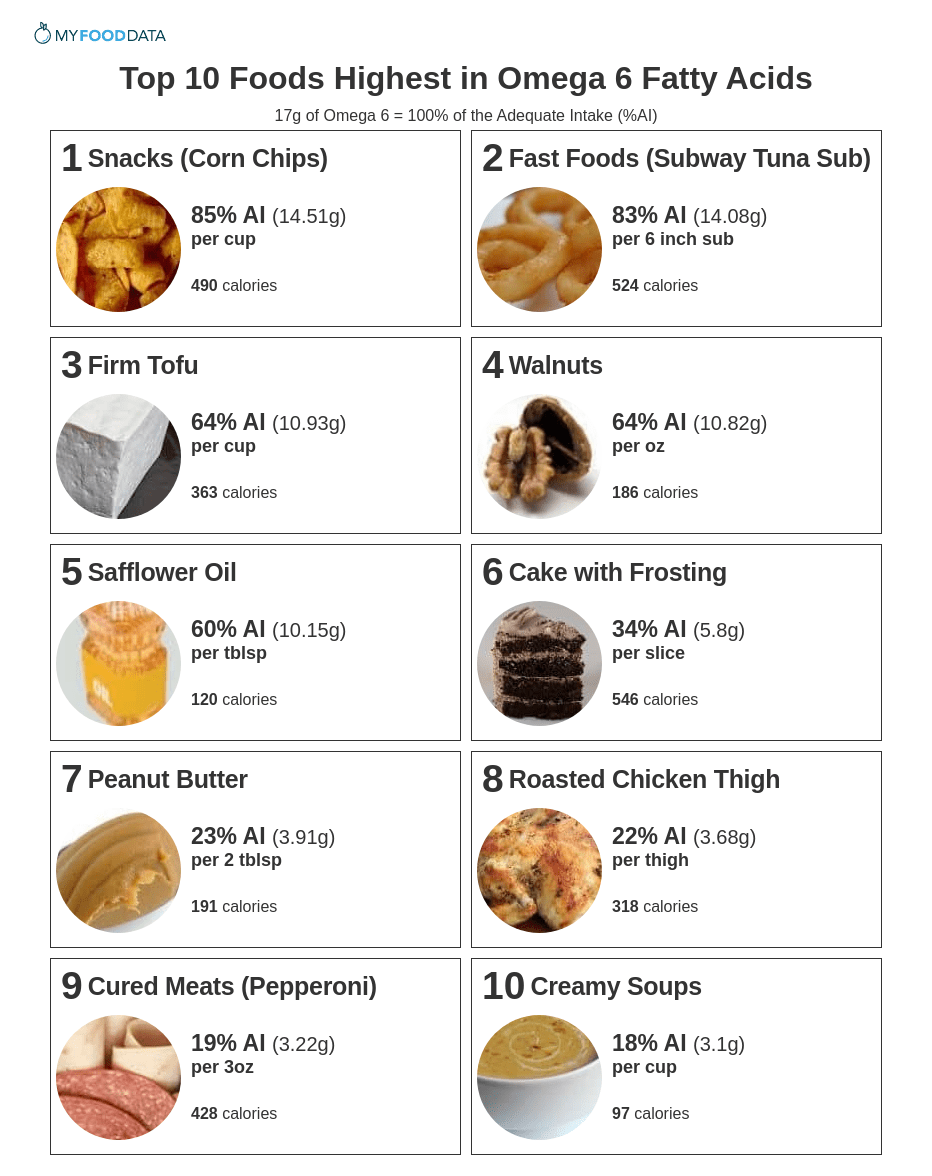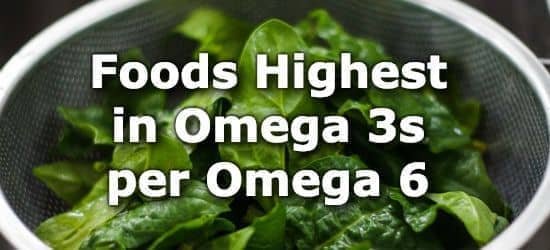Top 10 Foods Highest in Omega 6 Fatty Acids

Omega-6 fatty acids are a type of polyunsaturated fat naturally occurring in nuts, seeds and vegetable oils. Consumption of omega-6 fats has dramatically increased over recent years, due to the wide use of refined vegetable oils and their addition to processed and fast foods. (1)
While many sources of omega-6 are healthy, this large increase in consumption has been linked to health problems, including an increased risk of cardiovascular disease, cancer, inflammatory, and autoimmune diseases. (2)
What appears to be the problem is that the ratio of omega-6 to omega-3 fats in the diet has become too high. For some people, therefore, increasing omega 3 fats and limiting omega-6 consumption (especially from unhealthy sources) can be beneficial.
Unhealthy foods high in omega-6 fats include processed snacks, fast foods, cakes, fatty meats, and cured meats. Healthier sources of omega-6 fats include tofu, walnuts, and peanut butter. (3) Tofu and walnuts contain omega 3 fats and have a reasonable omega 3 to omega 6 ratio. The adequate intake (AI) for omega-6 foods is 17g per day for men and 12g for women. (4,5)
For more, please see the article of foods with the best omega 3 to 6 ratio, and the unfiltered list of over 200 foods high in omega 6 fats.
-
1g Omega 3 per 28g Omega 6
 1. Snacks (Corn Chips)
1. Snacks (Corn Chips)
Omega 6
per CupOmega 6
per 100gOmega 6
per 200 Calories14.51g
(85% AI)16.49g
(97% AI)5.92g
(35% AI)More Snacks High in Omega 6 Fats
- 31% AI per oz of potato chips (crisps)
- 30% AI per oz of corn tortilla chips
- 20% AI per oz of peanut granola bars
See all snacks high in omega 6 fats.
-
1g Omega 3 per 7g Omega 6
 2. Fast Foods (Subway Tuna Sub)
2. Fast Foods (Subway Tuna Sub)
Omega 6
per 6 Inch SubOmega 6
per 100gOmega 6
per 200 Calories14.08g
(83% AI)5.94g
(35% AI)5.38g
(32% AI)- 80% AI in 18 onion rings
- 77% AI per Burger King chicken sandwich
- 74% AI per KFC fried chicken breast
- 47% AI in McDonald's big breakfast
See all fast foods high in omega 6 fats.
-
1g Omega 3 per 7g Omega 6
 3. Firm Tofu
3. Firm Tofu
Omega 6
per CupOmega 6
per 100gOmega 6
per 200 Calories10.93g
(64% AI)4.34g
(26% AI)6.03g
(35% AI)More Soy Foods High in Omega 6 Fats
- 45% AI per cup of boiled soybeans
- 40% AI per cup of tempeh
- 28% AI per 1/2 cup of natto
Tofu is also high in omega 3 fats and is a healthy source of vegan protein and other nutrients.
-
1g Omega 3 per 4g Omega 6
 4. Walnuts
4. Walnuts
Omega 6
per OzOmega 6
per 100gOmega 6
per 200 Calories10.82g
(64% AI)38.09g
(224% AI)11.65g
(69% AI)More Nuts and Seeds High in Omega 6 Fats
- 55% AI per oz of sunflower seeds
- 34% AI per oz of pecans
- 24% per oz of pistachios
Walnuts are also high in omega 3 fats and are a heart-healthy source of many other nutrients.
See all nuts and seeds high in omega 6 fats. -
This food has no Omega 3 fats.
 5. Safflower Oil
5. Safflower Oil
Omega 6
per TblspOmega 6
per 100gOmega 6
per 200 Calories10.15g
(60% AI)74.62g
(439% AI)16.88g
(99% AI)More Oils High in Omega 6 Fats
- 56% AI per tblsp grapeseed oil
- 43% AI per tblsp corn oil
- 42% AI per tblsp walnut oil
- 41% AI per tblsp soybean oil
- 33% AI per tblsp sesame oil
See all oils high in omega 6 fats.
-
1g Omega 3 per 9g Omega 6
 6. Cake with Frosting
6. Cake with Frosting
Omega 6
per SliceOmega 6
per 100gOmega 6
per 200 Calories5.8g
(34% AI)4.03g
(24% AI)2.13g
(13% AI)More Baked Foods High in Omega 6 Fats
- 27% AI in a slice of pound cake
- 26% AI in a 4oz cream filled eclair
- 24% AI in a piece of blueberry pie
The amount of omega 6s will depend on the fat used in baking.
See the list of all baked foods high in omega 6 fats.
-
1g Omega 3 per 437g Omega 6
 7. Peanut Butter
7. Peanut Butter
Omega 6
per 2 TblspOmega 6
per 100gOmega 6
per 200 Calories3.91g
(23% AI)12.22g
(72% AI)4.09g
(24% AI)- 13% AI per tbsp of almond butter
Nut butters are a healthy source of vegan protein and other nutrients but watch your serving size as they are energy-dense. A tablespoon is a good serving size for most people.
-
1g Omega 3 per 21g Omega 6
 8. Roasted Chicken Thigh
8. Roasted Chicken Thigh
Omega 6
per ThighOmega 6
per 100gOmega 6
per 200 Calories3.68g
(22% AI)2.69g
(16% AI)2.31g
(14% AI)More Poultry High in Omega 6
- 17% AI per chicken wing
- 17% AI in a chicken hotdog
See all meats high in omega 6 fats.
-
1g Omega 3 per 23g Omega 6
 9. Cured Meats (Pepperoni)
9. Cured Meats (Pepperoni)
Omega 6
per 3ozOmega 6
per 100gOmega 6
per 200 Calories3.22g
(19% AI)3.78g
(22% AI)1.5g
(9% AI)More Pork High in Omega 6
- 22% AI in a rack of pork ribs
- 16% AI per 3 oz of salami
- 13% AI per cup of cured ham
See all meats high in omega 6 fats.
-
1g Omega 3 per 7g Omega 6
 10. Creamy Soups
10. Creamy Soups
Omega 6
per CupOmega 6
per 100gOmega 6
per 200 Calories3.1g
(18% AI)1.25g
(7% AI)6.42g
(38% AI)More Soups High in Omega 6
- 13% AI per cup of chicken soup
- 7% AI per cup of clam chowder
Printable One Page Sheet

How much Omega 6 fats do you need every day?
Below are the daily adequate intakes (%AI) established for omega 6 foods. Adequate intakes are used when there is not enough data to formulate a recommended dietary allowance (RDA). The adequate intake of omega 6 fats ranges between 4g - 17g per day for most people.
| Life Stage | RDA |
|---|---|
| Infants | |
| 0-6 months old | 4.4g |
| 7-12 months old | 4.6g |
| Children | |
| 1-3 years old | 7g |
| 4-8 years old | 10g |
| Males | |
| 9-13 years old | 12g |
| 14-18 years old | 16g |
| 19-50 years old | 17g |
| 51+ years old | 14g |
| Females | |
| 9-13 years old | 10g |
| 14-18 years old | 11g |
| 19-50 years old | 12g |
| 51+ years old | 11g |
| Pregnancy | |
| 14-50 years old | 13g |
| Lactation | |
| 14-50 years old | 13g |
About the Data
Data for the curated food lists comes from the USDA Food Data Central Repository.
You can check our data against the USDA by clicking the (Source) link at the bottom of each food listing.
Note: When checking data please be sure the serving sizes are the same. In the rare case you find any difference, please contact us and we will fix it right away.
About Nutrient Targets
Setting targets can provide a guide to healthy eating.
Some of the most popular targets include:- Daily Value (%DV) - The daily value (%DV) is a general guideline for consumption that will prevent deficiency of a particular nutrient in most people. The %DV refers to the percentage of an amount that\'s found in a single serving of a food. It also accounts for absorption factors. It is set by the U.S. FDA.
- Recommended Dietary Allowance (%RDA) - The RDA sets an average daily dietary intake level that is sufficient to meet the nutrient requirements of nearly all (97.5%) healthy individuals. It\'s more specific than the daily value, and varies by age and gender. The RDA is set by the US National Institutes of Health.
- Reference Dietary Intake (%RDI) -The reference dietary intake is similar to the recommended daily allowance, but is specific to age and gender. The RDI for amino acids is set by the U.N. World Health Organization.
- Adequate Intake (%AI) - This value is primarily used in reference to omega-3 and omega-6 fats. The Adequate Intake is set by the U.S. Institute of Medicine. Because there is less evidence to determine the ideal targets for consumption of these nutrients, the specific amount is considered to be less reliable. Using the term Adequate Intake, rather than one of the other terms, helps to emphasize that the ideal intake of that particular nutrient has not yet been scientifically determined.
See the Guide to Recommended Daily Intakes for more information.
Want to set your own targets? Sign up for an account and set custom targets in the daily food log.From the Nutrient Ranking Tool
Use the ranking tool links below to select foods and create your own food list to share or print.
- Foods High in Omega 6s
- Foods Low in Omega 6s
- Vegetables High in Omega 6s
- Fruits High in Omega 6s
- Vegetarian Foods High in Omega 6s
- Nuts High in Omega 6s
- Grains High in Omega 6s
- Beans High in Omega 6s
- Dairy High in Omega 6s
- Breakfast Cereals High in Omega 6s
- Fast Foods High in Omega 6s
View more nutrients with the nutrient ranking tool, or see ratios with the nutrient ratio tool.
Related
Data Sources and References
- Changes in consumption of omega-3 and omega-6 fatty acids in the United States during the 20th century.
- The importance of the ratio of omega-6/omega-3 essential fatty acids.
- U.S. Agricultural Research Service Food Data Central
- Dietary Reference Intakes for Energy, Carbohydrate, Fiber, Fat, Fatty Acids, Cholesterol, Protein, and Amino Acids. The National Academies Press.
- Oregan State University on Essential Fatty Acids
Try the recipe nutrition calculator, or daily meal planner.
Create a free account to log and track foods.

 Next ➞
Next ➞